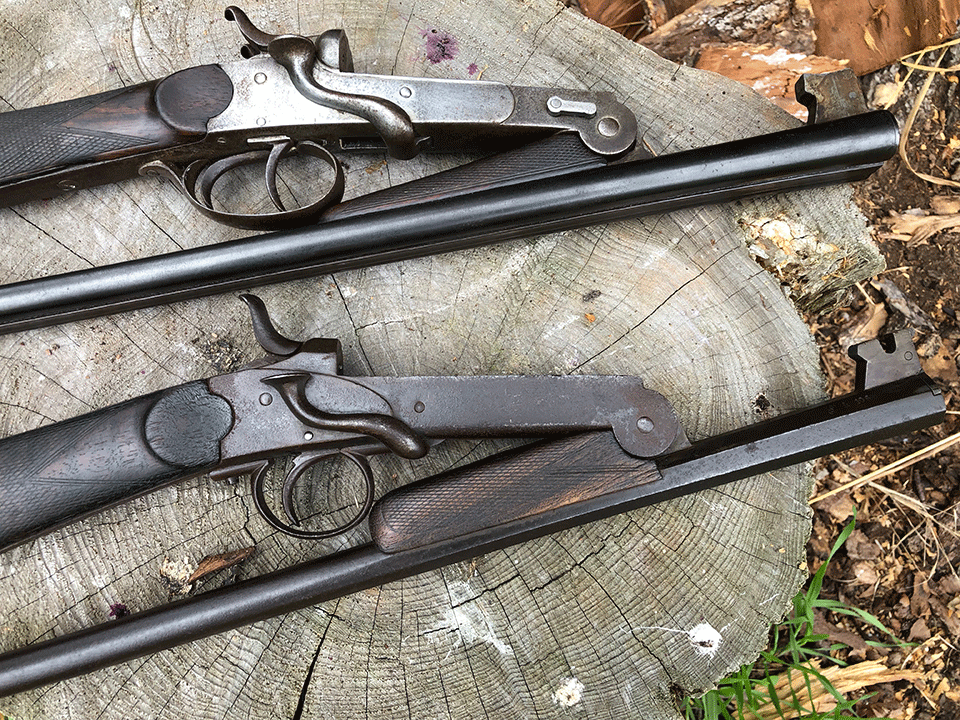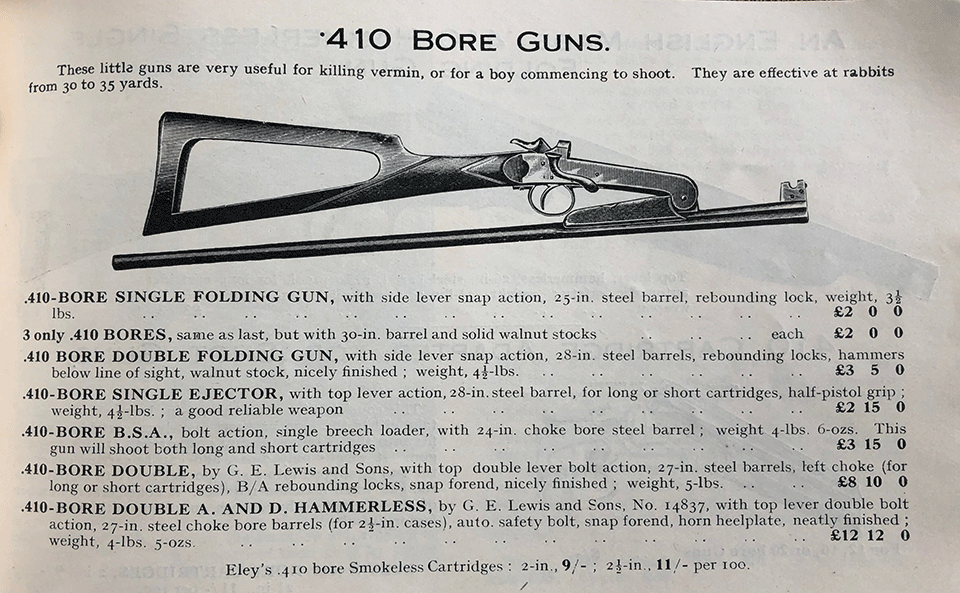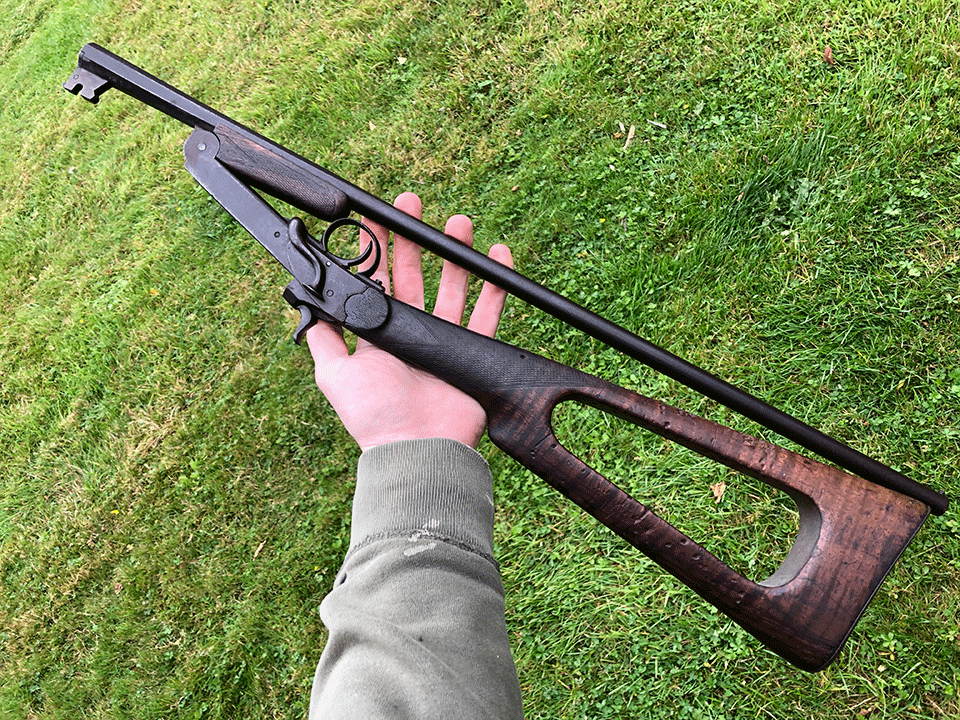We probably all have a romantic notion hidden away somewhere in our childhood memories of the figure of the old poacher, silently stalking a high hedgerow, out of sight and furtive on a windy evening, clad in a long coat from which he would pull out a folding .410, pot a rabbit or pheasant, then slip both offending object and spoils of crime back into the folds of his coat and innocently whistle his way home along the country lanes.
The romance of poaching has probably always been more fiction and folklore than fact but the image persists of the poor man taking ‘one for the pot’ in a small act of of defiance to the landed classes who held power over every other aspect of his life. His sport came with the element of risk. Perhaps to him, that was the sport.
Every now and then a gun arrives on the racks that elicits the same response from everyone who sees it; ‘a poacher’s gun’. I remember them from childhood, when every farmer had one in the barn or behind the door in the boot room. Now they usually come in with a deceased estate; last on the list, behind a good side-lock, a ‘rainy day’ boxlock and a, newer, AYA No.2.
These guns were once a common sight in the catalogues of British gunmakers, though they were not generally made in Britain. Unsurprisingly, they were not advertised as ’poacher’s guns’. Made in Belgium, often with no name or number to identify them, they are described in the G.E. Lewis catalogue of 1932 as ‘Single folding guns’.
Unsurprisingly, they were not advertised as ’poacher’s guns’.
The basic model is listed as ‘a .410-bore single folding gun, with side-lever snap action, 25” steel barrel, rebounding lock, weight 3 1/2 lbs.’ A solid stock version was also available with a 30” barrel at the same price.
The price was £2.00, which at the time would have bought you four hundred Eley .410 cartridges. That, in today’s money, would be akin to buying the gun for £123.00. An agricultural labourer made £1. 10s. 8d per week in 1932 so the gun represented about one and a half week’s wages. Grade 4 agricultural pay in 2019 is £320 per week. So, the little Belgian .410 represented the kind of outlay a modern Yildiz does to an agricultural labourer today.
Lewis tells readers ‘These little guns are very useful for killing vermin, or for a boy commencing to shoot. They are effective at rabbits from 30 to 35 yards.’
A double-barrelled version was available at £3. 5s 0d. This had 28” barrels, rebounding locks and weighed 4 1/2 lbs.
W.J. Jeffery, in his 1912 catalogue, describes these as the 'New Model Folding Pattern Collector's Gun' and advises 'They are strong, and well made. The .410 central fire cartridge will kill a rabbit at from 25 to 35 yards.' The price was £1.5s.0d or £2.00 if fitted with spring ejectors and 'Extra Quality'. The double barrelled version cost £3.00.
Those I see today are usually in the kind of condition one might expect from a tool that was intended for use around the farm or passed around the children of the family. Pitted barrels are the norm. However, they show their utility by the fact that most are shootable and still tolerably sound despite years of proper abuse.
There is something very ‘handy’ about them. They fold easily in half and, when folded, are comfortable to carry and easy to tuck into the footwell of a Land Rover or down the side of the seat. It was a common worry of the game keeper, when I was young, to keep an eye out for lorry drivers who may have such a weapon secreted inside the cab, with which they could bag the odd rabbit or pheasant from their vantage point above the hedge rows as they made deliveries in the countryside.
Of course, ownership was much easier in those days, with no licensing system operating until 1967 for shotguns and no requirement to list the shotguns you had until 1987. Today it is much harder to explain away the presence of a small shotgun in the cab of your vehicle.
You can buy these little .410s today for a few pounds. Twenty or thirty pounds in an auction will get you one that is shootable but which may benefit from a bit of home-restoration. The engineering is simple, they are robust and easy to dismantle with simple tools and make a great project for the beginner who wants to practice with something fun but isn’t yet skilled enough to trust himself on a decent English gun. With one of these, you can have a go at stripping, cleaning, tightening, polishing, blacking, cleaning-out chequer and preparing and re-finishing woodwork.
At the end of it you will have a handsome little gun that will be useful around the garden or orchard, or while doing the rounds to check on the pens.
You will also have a little piece of history and I challenge you not to feel that little tingle of excitement as the latent poacher in every countryman emerges at the feel of a .410 folded in-half and slipped snugly under his coat. You may even feel inclined to sew yourself a large pocket inside to accommodate it!
Published by Vintage Guns Ltd on (modified )




